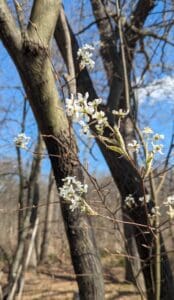
(Chelsea Update would like to thank Jennifer Fairfield of The Garden Mill for the information in this column. This is the second of two parts. The first part ran yesterday.)
Pruning
Late winter is the best time to prune many trees and shrubs because they are dormant.
Late winter is generally referred to by gardeners and arborists as February or even early March, after the coldest part of the season has passed, but before growth has begun. Pruning at this time of year is generally done to encourage lots of new growth in the spring, but you can also prune to remove dead or damaged branches, to create better growing conditions for other plants in your landscape, or to make mowing or walking around your trees or shrubs easier.
Though it is generally a good idea to wait to prune early spring-blooming trees and shrubs until after they have bloomed, they can be pruned at this time of year, if necessary. Just realize that you will not get as many blooms this spring because they produce blooms on last year’s growth.
There is one bonus to pruning these plants in winter, though – you can bring some of the branches in and force them into bloom to brighten up the house on dreary winter days.
If you’re not sure how to prune your trees or shrubs, you can find all kinds of information out on the web about proper pruning techniques.
I have to admit to still being intimidated by the whole thing, though. I am always afraid that I will do too much, so I tend to “nibble” (to quote an expert I know). This year though, I am determined to finally conquer my fears and get my trees and shrubs properly pruned.
I will be accomplishing that with a little help, and so can you, by joining us for a tree pruning workshop at The Garden Mill on March 1 at 11 a.m.
For the Birds
If you think the weather has been awful, how do you think the birds feel? Temperatures as low as we’ve been having force them to use more of their energy just to keep warm, so they need to take in more calories. This becomes a difficult task when everything is buried under snow deeper than most of them are tall.
Please consider feeding them now, even if you don’t usually. It could mean the difference between life and death for some of them.
The other necessity of life that birds have a hard time finding in these conditions is water. Providing a source of drinking water can also make life easier, or even possible, for our feathered friends. That’s easier said than done these days, but it is possible.
There are all kinds of options available, including bird-bath de-icers or heated baths (baths are also used as a source of drinking water by birds). I’m not a big fan of solar-heated bird baths because I don’t think they work very well in our area, since we often don’t have much sun in the winter.














